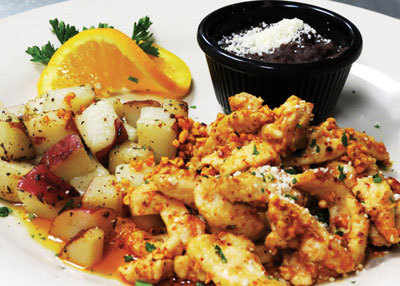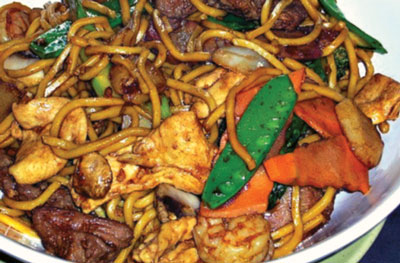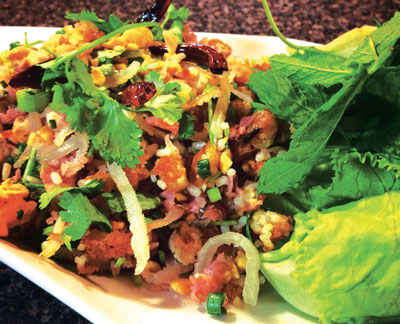Recipe for the holidays
The holidays aren’t just a time for gift giving, but rather breaking bread with loved ones and taking delight in wonderful scents wafting from the kitchen. From spicy to savory to sweet, recipes can evoke time-honored traditions. For five area restaurants, this season is full of delicious flavors that they’ve shared with FOX CITIES Magazine readers.
Twist on tradition
As the old adage goes, if you can’t stand the heat get out of the kitchen. For Chef Liborio Osorio, the holidays are a perfect time to throw in some unexpected flavor.
“You can spice it up as much as you want or keep it simple,” he says of his Chicken Chiltepin. Not only does the owner of Osorio’s Latin Fusion serve the dish at his restaurant, it’s also a favorite in his family at the holidays.
“With my mom, that’s a nice dish, a special occasion dish, that we enjoyed,” Osorio shares, adding his mother is still in Mexico where he grew up. “Keep Momma proud. … I think I feel her heart knowing that I’m making something she used to make for us. The gift that she has for cooking, I can say she gave to me or it’s in my blood. It’s magic.”
“It’s fun to see the cultures merge,” adds Kimberly Finnell of her husband’s traditions mixing with her own. “It’s a huge part of our culture at home.” Osorio and Finnell have a 6-year-old daughter, Melinda, and a 5-year-old son, Zander, who also enjoy cooking.
Finnell’s family is European, but has embraced Mexican cooking by adding a twist to things like Krumkake filled with Ancho Whipping Cream. Finnell and her mother cook for Christmas Eve with a multitude of appetizers and desserts while Osorio handles Christmas day.
“That’s how we play,” says Finnell of the fusion of cultures. “It just always kind of makes sense. It’s that time of decadence. That time when you indulge yourself.”
 Chef Liborio’s Chicken Chiltepin
Chef Liborio’s Chicken Chiltepin
Courtesy of Liborio Osorio, Osorio’s Latin Fusion
For Chicken:
1 whole chicken (recommended for best flavor; can substitute 21⁄2 pound chicken breast, if desired)
1 gallon water (enough to cover chicken)
1 whole onion, cut up
2 cloves of garlic
2 tablespoons salt
Boil chicken in a pot with water, onion, garlic cloves and salt until internal temperature has reached a minimum of 165 degrees. Debone chicken and discard boiling liquid. Set chicken aside.
Serves: About 6
For Chiltepin:
1 pound blanched peanuts
2 tablespoons whole Chile Piqueno or 1 tablespoon ground Chile Piquin
2 tablespoons granulated garlic
1 pinch ground cloves
½ teaspoon Mexican oregano
1 tablespoon smoked paprika
Salt to taste
1 tablespoon olive oil or 2 tablespoons butter
Using a food processor, grind peanuts and Chile Piqueno to chopped consistency (if using ground Chile Piquin, wait to add it with the rest of the spices). Mix ground peanuts mixture with the rest of the ingredients until fully incorporated. Set Chiltepin aside.
Heat olive oil or butter in a sautee pan over medium-high heat. Add chicken pieces and Chiltepin, and sautee until slightly crispy. Use as much or as little seasoning as you wish, depending on your heat tolerance.
Serves: About 10-12; keeps for 5 days covered and refrigerated
Ancho Whipping Cream
Courtesy Kimberly Finnell, Osorio’s Latin Fusion
1 pint heavy whipping cream
1 tablespoon Ancho Chile powder
¼ cup agave nectar
1½ tablespoon powdered sugar
Place a medium, metal bowl and beaters for your hand mixer in the freezer for 15 minutes. Remove from freezer, attach beaters to hand mixer. Pour cream into cold bowl and begin beating on medium-high speed setting. When cream is beginning to stiffen, add Ancho Chile powder and powdered sugar. Continue beating until stiff peaks begin to form. Slowly drizzle agave nectar into the bowl while continuing to beat the cream mixture. Beat until ingredients are fully incorporated and the mixture is stiff.
Noodling around
Life and longevity are important values in Asian culture.
“You actually don’t cut it, you’re supposed to eat it long,” explains Doris Ng, co-owner of GingeRootz Asian Grille with her sister Alice, of noodles, which are prepared for Chinese New Year. The noodles symbolize a long, prosperous life and are used in place of rice. The celebration falls between the regular New Year and the Lunar New Year from as early as late January to as late as February.
The noodles are cooked in soy sauce with simple ingredients, such as vegetables and chicken or beef. Ng’s family also typically serves yi mein, which is thicker than an egg noodle, the same color, but softer and chewier. This noodle is served by request at GingeRootz.
Seafood is another mainstay in New Year cooking and means “lively.” “Just the livelihood of life. There’s a lot going on. There’s never a dull moment,” Ng notes of the symbolism. When it comes to fish — like tilapia or sea bass — all parts from the head to the tail are prepared for eating. Steaming it is common to preserve flavor. Shrimp, lobster, king crab, oysters, clams and scallops also may be served.
GingeRootz does offer special menus during Chinese New Year to tie the event and cuisine together.
“Being a restaurant and also being of Chinese descent, food is very important to us,” Ng says. She grew up in New York and often went out to dinner for the holidays with her family to accommodate everyone at the table. GingeRootz hosts an annual dinner for employees with seven to eight dish variations and multiple pans of each.
 Lo Mein Noodles
Lo Mein Noodles
Courtesy of Doris Ng, GingeRootz Asian Grille
2 ounces julienne cut carrots
2 ounces julienne cut snowpeas
1⁄2 sweet onion, thinly sliced
1 ounce bean spouts
2-3 green onions, thinly sliced
1 tablespoon olive or vegetable oil
1⁄2 teaspoon minced garlic
16 ounces cooked lo mein noodles
Sauce
3-4 ounces cooked meat (as desired)
In a small bowl, combine the vegetable ingredients together. Heat wok, making sure oil is added onto the wok to prevent sticking. Then add garlic. Once heated, combine all vegetable ingredients into wok and stir-fry until vegetables soften up. Next, add the cooked noodles. Make sure that before you add them to the pan, they’re somewhat loose and not all clumped together (you can rinse them in warm water to loosen them up before adding them to the pan). Pour your sauce mixture over the noodles and stir-fry until the noodles are mixed evenly. Then add meat. Once everything is well-combined, dish out the noodles and serve.
For sauce:
2 ounces Kikkoman soy sauce,
1 ounce Maggie soy sauce,
1 ounce Dark Mushroom soy
½ ounce sugar
½ teaspoon sesame oil
Dash fresh ground ginger
1 teaspoon white cooking wine
Water to taste
Mix ingredients together.
Serves: Up to 2
One big family
“Just being Italian, everything is around food and cooking,” says Debbie Cannova-Rasmus, owner of Cannova’s Pizzeria & Fine Italian Dining. Growing up, she was exposed to two tables filled with food — one with turkey, ham, and pumpkin and apple pie, and the other with pasta, veal, fried eggplant and more — for 50-60 guests who would gather at the restaurant where her family also lived. The original Cannova’s dates back to 1921 with Cannova-Rasmus’ paternal grandparents.
She remembers having cannolis, a very traditional Sicilian dessert, on Christmas Eve. Her mother and aunts would be in the kitchen making the “little tubes” and filling them with ricotta. Some had candied fruit, while others had dark chocolate and the ends dipped in pistachios.
Today, Cannova-Rasmus continues to make the family filling, but now purchases shells from a Chicago bakery. Cannolis are available year round at Cannova’s. Ravioli was another familiar holiday recipe, which also is served at the restaurant.
“They’d all get together before the holidays and make a ton of ravioli,” Cannova-Rasmus says of the day-long gatherings that would take place with four to six women who would churn out hundreds of ravioli to be split among the group for a meal that night and again on Christmas Eve. “It was fun to watch them, they’d all be talking Italian,” Cannova-Rasmus shares.
Though her parents have since passed, she still enjoys the recipes and their kitchen table.
“It’s a piece of them that you still have. It’s who you are and where you come from,” she says. “There are very few things that people can open up over or pour your soul over like a meal.”
 Cannoli Filling
Cannoli Filling
Courtesy of Debbie Cannova-Rasmus, Cannova’s Pizzeria & Fine Italian Dining
2 cups ricotta
1 tablespoon vanilla
¾ cup powdered sugar
¼ cup heavy cream
¼ cup mini chocolate chips
6-8 shells (pre-purchased from Italian Bakery)
½ cup pistachios, finely chopped
Powdered sugar to taste for dusting
Whisk ingredients together until smooth. Fold in mini chocolate chips to cheese mixture. Place in pastry bag and fill shells when ready to serve. Dip ends of filled shells in finely chopped pistachios. Dust with powdered sugar.
For Homemade Ricotta:
1 gallon whole milk
½ cup lemon juice
½ teaspoon salt
Heat milk to a simmer and bring to foam. Remove from heat add lemon juice and salt. Stir well; it will begin to curdle. Preheat oven to 100 degrees and then turn off. Put curdled milk in oven and let rest for 6 hours. Line a collander with cheese cloth and pour mixture into cloth, squeezing out excess liquid. Continue to drain cheese in cloth in the refrigerator for several hours. Store in airtight container and salt to taste.
Serves: About 6-8 depending on size of shells
Coming together
“We tried to assimilate into American culture as much as we could,” says Larry Chomsisengphet, general manager of Basil Café, of holidays he recalls from his youth. “Stuffing is still always one of my go-to’s.”
Traditionally, however, Chomsisengphet says dishes like sticky rice, papaya salad, roasted pig and Chinese bakery served for Thanksgiving, Christmas and Chinese New Year were a staple in his family as a child and now. He was in utero when his family came to the United States in October 1983 with nothing. They had been in a refugee camp in Thailand for about three years prior before escaping Lao.
Nam Khao still brings back memories for Chomsisengphet. While not necessarily difficult to make, it is a time consuming recipe.
“Mom would be up really, really early making all these things,” Chomsisengphet says as if he’s picturing her in the kitchen. “The smells would be so delicious.” He recalls stealing the rice balls before they were mixed in with the rest of the dish. Today, his nieces do the same. “It’s naturally instinctive for a child to steal because it’s easy finger food,” he says with a chuckle.
“It’s all these great flavor profiles that make Lao cuisine what it is,” he adds. As a child, Chomsisengphet says he loved the crispiness of the lettuce, but also the “awesome, fluffy jasmine rice” inside the rice balls.
Gathering for a meal in Chomsisengphet’s household meant eating together and sharing stories in a communal or family style way with a big bowl of sticky rice and plates with various sides. Everyone shared off of one another.
“It always puts into perspective to me that we made it to America,” he says of the holidays and his desire to visit Lao. “The beauty and the mystery behind it invokes the wanderlust behind it.”
 Nam Khao
Nam Khao
Courtesy of Larry Chomsisengphet, Basil Café
For Rice Balls:
3 cups of cooked jasmine rice
2 tablespoons red curry paste
½ teaspoon ground white pepper
1 teaspoon of salt
Pinch of sugar
2 tablespoons finely chopped shallots
2 tablespoons finely chopped garlic
3 tablespoons finely minced lemongrass
1 cup grated coconut
2 eggs
1 gallon vegetable oil (for frying)
For Dressing:
1½ limes, juiced
1 cup chopped cilantro
1 cup chopped green onions
½ cup of crushed roasted peanuts
1 stick of nam/som moo (sour fermented pork), chopped (optional)
Sides:
Lettuce leaves
Cilantro
Mint
Lime wedges
Whole dried, roasted chilies (optional)
Break apart cooked rice clumps then combine rice, curry paste, white pepper, salt, sugar, shallots, garlic, lemongrass and coconut together. Using your hands, mix the ingredients together. Add eggs to rice, to act as a binder, and mix thoroughly and uniformly. Form rice balls by packing the rice tightly together into balls, about 3 inches in diameter, with no loose rice. Set rice balls aside and heat vegetable oil to 350 degrees to fry a few balls at a time.
Once oil gets to a stable 350 degrees, fry about 3-4 rice balls at a time as to not cool the oil too much (approximately 5 minutes). Once rice balls reach a dark golden brown color remove from oil, and set balls on top of paper towels to drain off excess oil and to let cool. Repeat until all the rice balls have been fried.
Once all rice balls have been fried and slightly cooled, break the rice balls apart into a bowl so that you have smaller chunks of the crispy rice amongst the inner fluffier rice.
Add to the rice and gently mix and toss together, the freshly squeezed lime juice, cilantro, green onions, crushed roasted peanuts and the chopped sour fermented pork (optional). Once thoroughly mixed, plate dish and serve with sides of lettuce leaves, cilantro, mint, lime wedges, and whole dried roasted chilies (optional).
Eaten like a lettuce wrap, take a lettuce leaf and create a bed and add the cilantro and mint. Scoop a little bit of rice onto the lettuce, wrap and take a bite! Typically eaten family style.
Serves: About 5 people
Bonus:
It’s in the pudding
For Mark Dougherty, owner of Mark’s East Side, the holidays are kicked off with Thanksgiving and some “ooey, gooey goodness,” otherwise known as Pumpkin Bread Pudding.
“We kind of created that one years ago at the restaurant and it’s got the good richness of the pumpkin, raisins and Captain Morgan,” says Dougherty.
“It took off and has been a good seller,” he adds. “People kind of wait for it.” Mark’s serves the Pumpkin Bread Pudding from November through December and rotates in other bread puddings created by cook Sara Berkovitz throughout the year — including White Chocolate Raspberry, Tiramisu and other seasonal selections.
“I would have to think the bread pudding leans more toward the German side,” Doughety says.
“Being Mark’s, everything is homemade, you can’t get it everywhere. … It’s fun flavors,” says Berkovitz. “I infuse a lot of my flavors with high-end liquors.”
Pumpkin Bread Pudding
Courtesy of Cook Sara Berkovitz, Mark’s East Side
1 loaf square white bread, cubed (cut 3×4)
1 1/2 29-ounce cans pumpkin
6 1/4 cups heavy cream
2 cups sugar
2 teaspoons baking powder
10 whole eggs
2 teaspoons vanilla extract
4 tablespoons Captain Morgan rum
Pinch of salt
1 1/2 teaspoons nutmeg
1 1/4 teaspoon cinnamon
1 1/4 cup golden raisins
4 tablespoons melted butter
Put cubed bread into a large bowl and set aside. Mix remaining ingredients together in another big bowl until completely combined. Pour pumpkin mixture over bread and gently mix together (hands covered in rubber gloves works well). All pumpkin mixture to soak into bread approximately 5-10 minutes. Mixture will be wet. Scoop mixture into small round ramekins or a 9-by-13 cake pan, plus loaf pan. If using ramekins, put them into a 2-inch deep 9-by-13 pan and fill pan with water to half the height of the ramekins. If using the pan method, take another 9-by-13 pan and fill it halfway, put it on the rack underneath the pudding. Put ramekins or pan into a preheated 350 degree oven and bake until firm to the touch; about 1 hour.
Servings: Makes approximately 16-20 small ramekins; 8-10 large ramekins
—FC










Leave a Comment